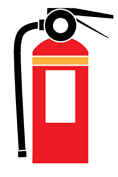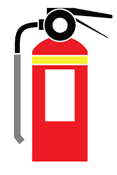Providing firefighting equipment is part of your responsibility as a business owner. All firefighting equipment must be positioned correctly and in effective working order. Below are the different types of extinguisher; please make sure you have the correct type(s) for your needs.
The Fire Risk Assessment Guides will provide relevant information on numbers and locations of firefighting equipment or this can be determined by contacting an approved fire extinguisher supplier. You must ensure that any type of make of fire extinguisher that you choose conforms to the relevant British Standards (BSEN3 and BS7863). The Kitemark or special British Approvals for Fire Equipment (BAFE) mark will confirm this.
Below are the various types and classifications of fire extinguisher available.
WATER
 This fire extinguisher is colour-coded Red and can be used for Class A fires, i.e. solids only, such as wood, paper and fabrics.
This fire extinguisher is colour-coded Red and can be used for Class A fires, i.e. solids only, such as wood, paper and fabrics.
This fire extinguisher is not suitable for Class B liquid fires e.g. paraffin, petrol, oil fires or where electricity is involved. It works by cooling burning material.
![]()
CO2
 This fire extinguisher is colour-coded Black and is ideal for fires involving electrical apparatus and Class B liquid fires. It does not cool and is not suitable for solids.
This fire extinguisher is colour-coded Black and is ideal for fires involving electrical apparatus and Class B liquid fires. It does not cool and is not suitable for solids.



DRY POWDER
 This fire extinguisher is colour-coded Blue and is a multi-purpose fire extinguisher that can be used on Class A, B and C fires. The fire extinguisher works by ‘knocking down’ the flames and is very effective in putting out fires.
This fire extinguisher is colour-coded Blue and is a multi-purpose fire extinguisher that can be used on Class A, B and C fires. The fire extinguisher works by ‘knocking down’ the flames and is very effective in putting out fires.
When used in confined spaces, a powder extinguisher could cause loss of visibility or aggravate breathing difficulties. This should be taken into account in your Fire Risk Assessment and Health & Safety Risk Assessment.
![]()



FOAM
 This fire extinguisher is colour-coded Cream and is more versatile than water. It can be used for both Class A and B fires. This fire extinguisher is not suitable for fires involving electricity. It forms a blanket or film on the surface of a burning liquid.
This fire extinguisher is colour-coded Cream and is more versatile than water. It can be used for both Class A and B fires. This fire extinguisher is not suitable for fires involving electricity. It forms a blanket or film on the surface of a burning liquid.
![]()

WET CHEMICAL
 This specialist fire extinguisher is colour-coded Yellow and is used for Class F cooking oil or fat fires only.
This specialist fire extinguisher is colour-coded Yellow and is used for Class F cooking oil or fat fires only.
It is not suitable for liquid, gas, or electrical fires.
![]()
Locations
Fire extinguishers should be accessible at all times, easy to use and indicated by signage. The main reason for the provision of fire extinguishers is to reduce the risk of a small fire becoming a large fire; by being able to attack the fire in its earliest stage of development, you can hopefully prevent it becoming a bigger incident.
Extinguishers should generally be located:
- In visible positions on brackets, stands or within cabinets.
- Where they can be seen by people following an escape route.
- Near to room exits, corridors, stairways, lobbies and landings.
- In similar positions on each floor to provide consistency.
They should not be located:
- Where a fire may prevent access to them.
- In concealed positions.
- Where they may cause obstructions on escape routes.
- In rooms away from escape routes, unless they are required for a specific hazard.
- Where they may be damaged or be at risk of vandalism, such as high traffic routes.
Testing and maintenance
As the responsible person, you should ensure that all firefighting equipment is subject to a regular visual check and that maintenance and testing is carried out by a competent person (i.e. a person with the appropriate knowledge and training to carry out the task).
This maintenance programme should be carried out in accordance with the relevant British Standard, to ensure that all firefighting equipment is immediately available to use when it is required.
Records of the inspection, testing and maintenance schedule should be kept as evidence for when fire safety inspectors visit your premises. Some premises are subject to specific maintenance requirements, which are detailed in the legislation applying to that type of premises.

